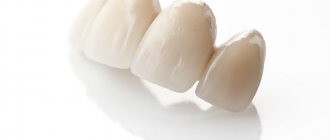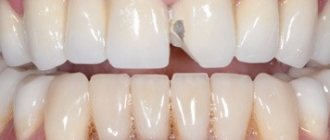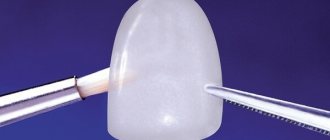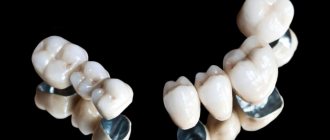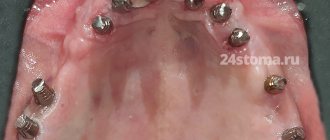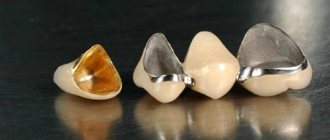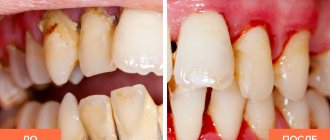Modern dentistry can offer different types of orthopedic structures, including metal-ceramic crowns, for successful reconstruction of lost teeth. We will discuss the features of metal-ceramic crowns in detail below: we will consider their structure, stages of production and installation, advantages and disadvantages, and the cost of metal-ceramic crowns for teeth.
Calculate the cost of treatment by taking a short test in 20 seconds!
Do not delay your treatment, because in this matter time plays against us.
General information and unique features
Metal-ceramic crowns are one of the most popular types of orthodontic structures among dental patients. The increased demand for this particular type of orthopedic products is explained by their durability, high aesthetics and impeccable positive results in the restoration of lost teeth. The price of metal-ceramic crowns is an order of magnitude higher than that of crowns made of metal alloys, but at the same time they are more affordable than designs made of expensive dental porcelain.
Metal-ceramic crowns have a special design: inside there is a strong frame base made of metal alloy, which is covered on the outside with a dental porcelain finish. The finish is applied to the frame base of the crown in layers: and each layer of applied material undergoes heat treatment in a specialized oven at elevated temperatures.
Layer-by-layer application and subsequent heat treatment provide super-strong adhesion between the metal base and the ceramic composition applied to it. Below we post a photo of a metal-ceramic crown; after studying it, you can see exactly what it looks like.
Further in the material, we will thoroughly understand the advantages and disadvantages of metal-ceramic crowns, and also find out why there is a fairly large price range in dental clinics for the cost of metal-ceramic crowns with work, and we will explain in detail why in this case the lowest price offer is not the most profitable, on the contrary, it can significantly increase costs.
What are the best crowns for front teeth?
Today, dental clinics use several options for orthopedic structures for front teeth: metal-ceramic prostheses, zirconium crowns, solid ceramic products and improved E-MAX models.
Many visitors to modern dentistry are interested in: “Which crowns are best to fix on the upper front teeth?” In this case, the preferred option would be to install all-ceramic structures. For the manufacture of prostheses of the above type, porcelain material is used, obtained by injection molding or by layer-by-layer application. Alternative designs also include ceramic prostheses on a zirconium base.
Points to consider
If you definitely decide to install a metal-ceramic crown, then you should definitely take into account that different types of metal-ceramic products differ not only in price, but also in service life, aesthetic indicators, reliability and strength characteristics. We will tell you more about the types of metal-ceramic crowns below, but for now we will make one more important note: when planning to install a metal-ceramic crown in dentistry, it is extremely important to choose the right clinic to receive this service. Even the most expensive and well-made metal-ceramic crown will not last long if:
- The dental units were poorly prepared and ground for the installation of a metal-ceramic crown;
- When taking impressions for its manufacture, the specialist made a mistake.
Preparatory procedures for installing a metal-ceramic crown always begin with sanitation of the oral cavity and treatment of all diseases of the teeth and oral cavity identified during the examination. If the root canals of the tooth are treated incorrectly, errors are made in their filling - in the future there is a high risk of an inflammatory process occurring in them. The occurrence of inflammation can lead to the fact that the prosthesis will have to be removed, treated, and then all restoration manipulations will have to be carried out from the very beginning.
To prevent such negative consequences, the doctor must refer you for a control X-ray examination after therapeutic and other manipulations: pulp removal, canal filling.
No less important are the quality of grinding teeth for crowns and the accuracy when taking impressions. If the doctor makes a mistake at this stage of treatment or uses an inexpensive material that cannot accurately convey all the individual characteristics of the teeth, the finished crown will not adhere to their surfaces with the required degree of density. Saliva will constantly flow under it, and pathogenic microorganisms will enter, provoking the development of caries and decay in dental tissues.
For these reasons, it is recommended that before starting treatment and installing metal-ceramic crowns, make sure that you turn to professionals. Dental prosthetic services of European quality level are provided in our dental clinic in Moscow - Vanstom. If you want to find out the cost of a metal-ceramic crown, get professional advice on prosthetics from an experienced and competent specialist - come to our Vanstom dentistry! We are located in the center of Moscow, our exact address: Moscow, Baumanskaya metro station, st. Bakuninskaya, 17/28.
Dentistry. Metal-ceramic prosthetics: pros and cons
Having decided to visit the dentist to restore the integrity of the dentition, many patients are interested in the question of whether metal-ceramic dental prosthetics can harm their health or not. A-Medic specialists claim that if the production of metal ceramics is carried out from high-quality certified materials in a professional laboratory, then the risk of complications after prosthetics is minimized.
The dentures are entirely made of non-toxic materials. Individual side effects and complications after implantation in the jaw are caused, to a greater extent, by the characteristics of the body and oral cavity of a particular patient.
The reasons why most patients choose a combination of metal and ceramics are:
- cost of metal-ceramic prosthetics;
- strength;
- lifetime;
- aesthetic indicators.
The disadvantage of this technology for restoring the integrity of the dentition is the need for deeper treatment of the living tissues of the adjacent tooth. However, if the dentist is properly experienced and the work is done carefully, this side effect will wear off.
Types of metal-ceramic crowns
In Moscow dentistry, metal-ceramic crowns for restoring lost or severely damaged teeth can be offered in three main types:
- Traditional crowns;
- Products from precious metal alloys;
- Crowns made using specialized milling equipment.
The price of metal-ceramic dental crowns will largely depend on their type, and therefore you should familiarize yourself with the features of each type in advance. Let's look at the characteristics of different types of metal-ceramic crowns below.
Is it necessary to prepare remaining teeth for prosthetics?
If, with the help of implantation, it is necessary to restore single defects, and the teeth adjacent to these defects are not in very good condition - they are chipped, they were filled several times after treatment of caries or pulpitis, then they can also be covered with crowns. Here you can use both metal-ceramic teeth (similar to those that will be placed on implants), and ceramic or ceramic-composite teeth - in any case, such teeth are pre-ground.
If you need to install a bridge, then there is no need to grind down the adjacent healthy teeth - after all, it is impossible to fix the bridge to an implant and a natural tooth at the same time. This is explained by the natural micromobility of natural teeth and the lack of such mobility in implants (they are tightly fixed in the bone and do not move). If an implantologist offers such an option, then this calls into question the doctor’s qualifications, and it is not worth treating with him. Otherwise, the patient will simply waste time and money, because... The implant will eventually become mobile and fall out along with the bridge.
Traditional metal-ceramic crowns
For classic metal-ceramic crowns, prices in Moscow are offered at relatively affordable prices, since alloys from available metals - cobalt, chromium - are used to create the frame base. The frame part turns out to be quite strong, but there is one significant nuance: it is not completely processed with ceramic mass; without a layer of ceramics, a small ledge remains in the area of contact of the prosthesis with the gum. This entails contact of the metal surface with soft tissues, which is why the gums take on a distinct, unsightly bluish tint.
You can avoid this negative phenomenon by ordering the production of a metal-ceramic crown with shoulder mass. In this type of crown, the ledge is also covered with ceramic, like the rest of the frame, but its production will cost more.
How do you know if it’s time to change the crown or if it can still serve?
There are objective signs that reflect the condition of crowns/bridges, which are assessed by an orthopedic dentist during a routine examination:
- service life of the crown/prosthesis
- patient complaints (pain, food getting stuck near the crown, unpleasant odor near the crown, and others)
- fit of the crown to the tooth (marginal fit)
- the presence of areas of plaque accumulation
- condition of the gums next to the crown (color, bleeding, density, presence of other signs of inflammation, raising the edge of the gums (exposure of the root))
- presence of signs of inflammation of the bone tissue around the tooth with a crown
- density of interdental contact (crowns with adjacent teeth).
If one or a number of signs are present, the doctor decides whether the crown needs to be replaced.
Crowns with a frame base made of precious metals
The frame part of a metal-ceramic crown may be made from alloys of precious metals. The cost of a metal-ceramic crown in Moscow in this version will depend on the weight of the precious metal, as well as on its type and, naturally, will be higher than the price of a product with a cobalt-chrome frame. The advantage of this type of crown is their increased strength and more aesthetic appearance.
The use of metal-ceramics in prosthetics on implants
Metal ceramics are an excellent option for use on implants. For example, it is impossible to install pure ceramics on metal roots, since they are much stronger than the material of the upper part, and under pressure the ceramics will simply fall apart. This will not happen with metal-ceramics - when fixed to implants, the internal metal base comes into contact with their top and this combination is extremely strong and durable. But external ceramics serve only to create aesthetics.
Crowns using computer technology
When producing a metal-ceramic crown of this type, its frame part is not cast from molten metal, but is produced on specialized milling equipment using an innovative CAD/CAM program. The use of this technology in the production of crowns makes it possible to produce a prosthesis that is ideally suited for a specific clinical case and has the highest possible degree of adherence to the dental surfaces, and this has a positive effect on both the strength of the crown itself and the aesthetics of the restoration as a whole.
For such metal-ceramic crowns and teeth, the price in Moscow starts from 20,000 rubles. What will determine the price of a metal-ceramic crown, what factors are involved and whether it is worth saving on the service by choosing cheap products - we will look at these pressing issues in detail in the next section of the article.
Free consultation
Our specialists will conduct a free consultation and select the best treatment option for you.
Sign up now! Online registration
+7 (495) 649-41-19
e.max crowns on front teeth
When considering crowns for the front teeth, we strive to give a clear answer as to which ones are better aesthetically and functionally. The undisputed leader in this direction is Emax glass ceramics. This is an improved modern material, the creation of which is based on the use of lithium disilicate, which has impeccable characteristics. Emax ceramic crowns look perfect on the front teeth because they have light transmission that fully matches natural enamel. The same can be said about veneers made from the above material; they are completely indistinguishable from natural teeth
Today there are 2 known options for Emax materials:
- E.maxPRESS. Widely used to obtain dentures and veneers. This involves the injection molding method under the influence of pressure and high temperature conditions. Such crowns are indispensable when restoring single teeth or creating short bridge structures.
- E.maxCAD. In the production of this material, modern computer technologies and computer-controlled machines are used. Such crowns are characterized by less high reliability, which eliminates the possibility of creating bridge structures and ultra-thin veneers. Also among the disadvantages of E.maxCAD is the limited selection of shades, which reduces the chances of obtaining a design identical in color to natural enamel.
Cobalt-chrome crowns
Making a metal-ceramic crown from a cobalt-chrome alloy will be cheaper than making an analogue from precious metal or with a milled frame. If high-quality materials from German manufacturers are used for production, the average cost of a crown can be from 11,500 rubles. This price is relevant for prostheses without shoulder mass; products with this element will cost more - from 15,000 rubles.
However, you can see advertisements in which the price of a crown is much lower - from 5,000 rubles. You should not be tempted by the cheapness of the service, since the production of such inexpensive crowns uses low-quality materials and therefore the savings in fact are very doubtful. A frame made from cheap materials can break, and the ceramic layer can constantly chip off.
What to do in case of crown fractures?
The crown of the upper front tooth may need to be replaced, the need for which may arise if there are cracks and chips on it or if the supporting unit is damaged. In such a situation, it is advisable to fix a new orthopedic design. In this case, the best option would be if the crown is placed on the front tooth implant. To avoid unwanted consequences, you must strictly adhere to the recommendations for cleaning the oral cavity and undergo regular examinations by a specialist. If the structure becomes loose, you should immediately visit a dentist.
Crowns made of an alloy of gold and platinum (palladium)
Reviews about metal-ceramic crowns are mostly positive, but the production of such a prosthesis will cost you no less than 15,950 rubles. This figure will take into account not only the basic materials, but also the price of gold and other precious metals that will be used to obtain the alloy for the production of the crown base.
It will cost you the most to make crowns using the CAD/CAM system, but their high price is fully justified by the long service life of metal-ceramic crowns and high aesthetic performance. However, the final price of the crown may also include additional costs, including:
- 1. Production of temporary crowns from plastic and other types of polymers. It is impossible to do without the production of a temporary prosthesis made of plastic if the restoration is performed in the smile area.
- 2. Installation of a turnkey metal-ceramic crown involves preliminary treatment of the teeth, which is calculated separately and included in the final cost of the service.
Prices for metal-ceramic crowns seem high, but they are an order of magnitude lower than the cost of reconstruction with metal-free ceramic products and veneers. Moreover, the cost of the procedure will be paid off by the high quality and durability of the restoration result. How to choose the best metal-ceramic crowns without making a mistake with either price or quality - you can always ask Vanstom specialists this question! To make an initial appointment, just dial our contact phone number! Or come to our clinic at the address: Moscow, Baumanskaya metro station, st. Bakuninskaya, 17/28.
Do I need to prepare implants and gums for prosthetics?
Not everyone knows how to insert a metal-ceramic crown into an implant. In fact, these two components are not enough - first you need to screw the abutment into the implant, and then fix the metal-ceramic “cap” on it. Either the prosthesis is connected to the abutment in a dental laboratory, and then the entire structure is fixed to the implant.
Read on the topic: what is an abutment, why is it needed in implantation, and what an abutment can be.
To achieve a beautiful gingival contour around the future restoration, 1-5 months after implantation of the implant, the plug is removed from it and a gum former is installed on top. This is required for single restorations, when the prosthesis does not contain artificial gum, which would mask the uneven gingival margin. After the contour of the mucous membrane is formed, the former is removed and an abutment is placed - and a prosthesis is placed on it. If the front tooth is being restored, then the role of the former is played by the abutment, covered with a temporary placer removed from the bite.
Review of advantages and disadvantages
Metal-ceramic crowns have both advantages and disadvantages, which you should familiarize yourself with as carefully and in detail as possible in order to make the right decision for yourself. Let's start with a quick overview of the pros.
- High-quality made and installed metal-ceramic crowns are distinguished by solid strength and durability. Their average service life is up to 15 years and at the same time they do not lose either their useful functionality or aesthetics.
- It is almost impossible to visually distinguish the finishing coating of crowns from natural teeth, which makes it possible to install metal-ceramic crowns on the front teeth included in the smile zone.
- When making a prosthesis, they can make you a metal-ceramic crown of the required color shade, which will match the tone of the natural enamel coating.
The outer ceramic layer of the prosthesis has a smooth and pore-free surface, and thanks to this, pathogenic microorganisms do not accumulate on its surface and deposits do not form. Crowns are quite easy to care for and, of course, among the advantages of the products it is worth mentioning the optimal balance between their cost and quality.
However, it is worth considering that metal-ceramic crowns also have disadvantages, to which experts include the following important features:
1. Metal-ceramic crowns cannot be used if a person has an allergic reaction to metals and their alloys. Moreover, if a person already has metal dentures in the oral cavity, then installing a crown made of a different alloy can provoke a galvanic effect - a phenomenon that causes an unpleasant metallic taste in the mouth, and also provokes a number of soft tissue diseases.
2. When installed on the front teeth, a metal-ceramic crown may not provide the required aesthetics, which is especially important if a person has naturally thin and transparent enamel. The restored unit will stand out noticeably against the natural teeth. Therefore, when carrying out restorative manipulations in the smile area, dentists advise using other types of orthopedic products - for example, metal-free crowns. If you need to restore chewing teeth, then metal-ceramics will be one of the best options, even if the crown is made without a shoulder element.
3. Possible change in the color of soft tissues and the appearance of a dark stripe at the edge of the prosthesis. These problems arise if standard metal-ceramic crowns without shoulder mass are chosen for reconstruction. The gum acquires a bluish tint due to the fact that the edge of the installed crown, which is not covered with a layer of ceramics, is closely adjacent to it. This is especially critical if restorative procedures are carried out in the frontal area and where the gums are clearly visible when smiling.
The appearance of a dark line in the restoration area is explained by the gradual descent of the gums downwards, as a result of which the metal not covered with ceramics will be visible. If you want to avoid such problems, you should initially order crowns with a shoulder element. They are more expensive than standard options, but at the same time they do not have areas without a ceramic coating and therefore their aesthetic indicator is much higher.
Dentists recognize that a significant disadvantage of metal-ceramic crowns is the need for grinding of teeth, during which a fairly large amount of natural tissue is ground off from the tooth. Teeth are treated over their entire surface, from the inside and outside, and the tissue is removed to a depth of two millimeters. Removing such a significant amount of natural tissue negatively affects the health of the tooth, making it more fragile and vulnerable to the action of harmful bacteria.
One of the disadvantages of metal-ceramic crowns is definitely the need that arises in some circumstances for preliminary depulpation of the tooth. This decision is made by the doctor in cases where the volume of tissue removed during grinding will be maximum: when a significant amount of dentin is removed, the risks of pulp burns and nerve death during further manipulations increase significantly.
Usually, teeth located in the smile zone are depulped, since they have less dentin thickness, but chewing teeth are preferably not depulped and left with a living nerve. You can get detailed advice about all the features of metal-ceramic crowns at an appointment with a specialist from our dentistry in Moscow - Vanstom!
Why do we need to change?
There are a number of reasons for this:
- Over time, the product loses its color and shape, especially when a low-quality prosthesis is installed or when the technological process of prosthetics is violated. The materials from which they are made absorb coloring substances contained in food and drinks. This causes darkening and highlighting of the dentition;
- individual intolerance to the composition from which the crown/bridge is made;
- inflammation of the gums, constant feeling of discomfort. The condition of the tissue around the supporting tooth directly affects the durability of the structure itself, which often leads to its loosening. Symptoms such as the appearance of blood during cleaning, swelling and redness should not be ignored. It is important to immediately make an appointment with a doctor and begin treatment;
- the support that is necessary for installing the orthopedic product is destroyed. As a rule, this is associated with the manifestation of caries, due to which the remaining part of the tooth dies over time, and the strength of the fixation is impaired;
- Some people experience changes in bone tissue, which leads to visible changes in the proportionality and structure of the jaw. This is because bridges cannot stop bone atrophy, in which the gums and jaw become smaller over time. And if the orthopedic design no longer matches the gums and jaw, then its stability is lost and the need for correction or replacement arises.
The main stages of dental prosthetics with metal-ceramic crowns
Reconstruction of lost or severely damaged teeth with metal-ceramic crowns is relatively quick. Even taking into account preliminary therapy and high-quality sanitation of the oral cavity, the installation of turnkey crowns will take no more than 2 weeks. Attention! If the clinic promises to make crowns in less time, then this is a serious reason to be wary, since a high-quality prosthesis cannot be made in a couple of days.
Metal ceramics prosthetics. Features of caring for orodontic structures
There are no super complex rules for caring for ceramic teeth. Dentists recommend that patients undergoing prosthetics adhere to standard hygiene standards. When cleaning your mouth, you need to follow these simple rules:
- Brushing your teeth twice a day and rinsing your mouth after every meal.
- No special hygiene products or brushes are required; standard accessories will do.
- The movements of the brush should be sweeping, directed from the edge of the gums to the edge of the tooth.
- Dental floss is allowed.
To avoid the development of symptoms of secondary caries, experts advise not to forget about regular visits to the dentist. This will help eliminate destructive processes under the crown at the stage of their inception. If necessary, the dentist can perform crown restoration directly in the patient's mouth. This is necessary if the prosthesis has chipped or cracked. Such situations are extremely rare, but they also occur when the orodontic structure is used carelessly. Restoration with composite materials is only possible if the metal frame is not completely exposed, otherwise a complete replacement of the crown will be required.
Restorative procedures involving the installation of metal-ceramic crowns are divided into the following stages
Preparatory stage.
The patient comes to the clinic and undergoes an examination in the dentist's office. An X-ray examination is required, which can show whether there is inflammation in the area of the tooth, which will later be restored with a metal-ceramic crown. If symptoms of inflammation are present, then you will need to treat the tooth by carefully treating and filling the canals. If the tooth canals have been treated previously, then the quality of their filling will certainly be checked.
If the examination reveals that the patient has caries or other dental diseases, worn out old fillings, all this must be eliminated before the teeth are turned and prepared for a metal crown. The installation of a metal crown does not always require preparation (removal of the pulp and nerve), mainly in cases of restoration of anterior teeth and with one root, but dentists prefer not to subject chewing teeth to this procedure without clear indications.
A tooth in which more than 50% of the crown is destroyed is restored: for this, a pin is screwed into the canal, after which the coronal part of the unit is built up with a filling composite. Installing a pin allows you to give the filling the required degree of strength necessary for the restored crown to be able to withstand the stress of chewing food.
But there are cases when the tooth is left with extremely thin walls, or even just one root. In this case, before restoring the unit with a metal-ceramic crown, a special inlay is installed in the tooth. The metal-ceramic crown is firmly fixed to it, and the inlay helps protect the prosthesis from breaking under load.
Prosthetics stage
After all the preparatory procedures are completed, teeth grinding begins. The unit on which the crown will be installed is ground on all sides to the thickness of the future prosthesis. After this is done, an impression is taken from the teeth, which is sent to the laboratory, where a dental technician will use it to make a metal-ceramic crown.
While the metal-ceramic crown is being made, the patient is offered a temporary prosthesis. Plastic structures are especially relevant for prosthetics in the smile area - they will help maintain its aesthetics. In addition, the temporary crown will protect the ground teeth from the negative effects of external factors.
An important point: it is worth knowing that the cost of preparing each tooth for installation of a prosthesis can range from 4,000 to 10,000 rubles, and therefore sometimes it may be more profitable to install a metal-ceramic crown on an implant. This is especially true for cases where only one tooth needs to be restored. In such circumstances, a metal-ceramic crown on an implant will not only reduce the cost of prosthetics, but also will not require grinding of adjacent supporting and healthy teeth.
What should I replace the bridge with or what is the alternative?
If a patient has lost one tooth, then he is faced with the question of what to choose to restore the dentition. Typically, your doctor will suggest installing a dental bridge or implant.
Recently, implantation has been considered the most reliable and durable method of restoration, since the “artificial root” cannot be distinguished in the oral cavity from a regular tooth. You can choose a combined option when several teeth are missing in a row. Instead of an abutment tooth, a bridge is installed on an implant.
But the best solution for maintaining oral health is to undergo timely medical examinations, which will allow you not to lose your teeth.
Which is better: zirconium or metal-ceramic crowns?
The question of which crowns are better—metal-ceramic or zirconium dioxide—patients often ask dentists during consultations on prosthetics. This question can be answered this way: in terms of aesthetics, zirconium dentures are better than metal-ceramic crowns. However, if your natural enamel has a high degree of transparency, zirconium will not be the best material for the production of a prosthesis.
The zirconium dioxide frame is bright white and lacks transparency, and therefore the finished crowns will look unnatural against the background of other teeth in the row. If the enamel is highly transparent, it is best to give preference to crowns made from a separate type of dental porcelain - lithium disilicate.
If teeth restoration needs to be carried out in the area of chewing units, then zirconium crowns will be a good option, but there is one caveat - possible frequent chipping of the ceramic layer from the base of the frame. It is especially not recommended to install zirconium crowns on chewing teeth with an abnormal bite. In case of bite defects, the solution may be to install either metal-ceramic crowns or zirconium prostheses, but without applying layers of porcelain.
For prosthetics on the lateral chewing units, which experience maximum load when eating and chewing food, the best option may be duceram metal-ceramic crowns, produced by a German dental brand. The design of metal-ceramic crowns of this brand is unique - the proportion of ceramics in it is several times higher than the metal content and this not only has a positive effect on the strength of the prosthesis as a whole, but also significantly improves the aesthetics of the finished crowns.
Installing duceram metal-ceramic crowns will not be cheap - about 10,000 rubles per tooth, but the cost of prosthetics with this type of structure will be fully compensated by their durability and high quality. This type of metal-ceramic crowns cannot be recommended for prosthetics in the area of the front teeth; the difference between the prosthesis and natural teeth may be noticeable.
What specific type of crowns for prosthetics will be optimal in your case - this question is best discussed with the specialists of our dentistry in Moscow - Vanstom! To make an appointment at our clinic, just dial the contact phone number!
Calculate the cost of treatment by taking a short test in 20 seconds!
Do not delay your treatment, because in this matter time plays against us.
Metal-ceramic teeth. How has the material proven itself?
Metal-ceramic dentures are a crown or bridge on a metal frame coated with ceramic. The orthodontic design is identical to the shape of a real tooth, so the prosthesis is easily installed in the jaw and does not cause discomfort to the patient while wearing it. According to statistics, metal-ceramic implants are much less likely than other prostheses to cause an allergic reaction. Most often, specialists at the A-Medic clinic use ceramic prostheses to restore teeth in the chewing region. The material has proven itself optimally not only from an aesthetic, but also from a practical point of view. The main advantages of metal-ceramic prostheses are:
- reliability;
- functionality;
- aesthetic indicators;
- ease of installation;
- affordable price for most patients.
Thanks to the unique properties of ceramics, the dentist has the opportunity to select a prosthesis whose shade best matches the color of the client’s own teeth. Provided that it is installed properly, a ceramic-coated implant is invisible in the mouth and therefore does not cause psychological discomfort to a person.
Service life of crowns, reviews
If you look for information about metal-ceramic crowns on websites on the Internet, you may notice that people often write negative reviews about this type of orthodontic products. But it is not the designs themselves that are to blame for this, but the poor quality of their manufacture, the incorrect preparation of the process of preparing for prosthetics with metal-ceramic crowns and its main stages. Below we will consider all the problems that may arise due to low quality of service.
1. Low aesthetics. After installing the crown in place, many people begin to complain that it stands out noticeably against the background of natural teeth. To prevent this from happening to you, the aesthetics of the crown must be assessed at the stage of trying it on, and if you are not satisfied with something, do not remain silent, but directly voice your complaints to the specialist leading your treatment.
2. Discomfort in everyday use. It can also be detected at the fitting stage. The crown may not fit tightly onto the prepared unit, or the patient will notice that he cannot close his jaw normally because the denture is too high. Such defects indicate that an impression was taken incorrectly and inaccurately from the ground teeth. There is only one solution to the situation - insist that the crown be redone for you. If the doctor offers you to correct the problem by cutting it down with a drill, this will indicate his incompetence and low level of professionalism, since such manipulations negatively affect the strength of the structure.
Remember, the crown should not prevent you from closing your teeth or speaking, and in addition, it is important that it fits tightly to the tooth surfaces, since the presence of even a small gap is a risk of developing various dental pathologies.
3. After installing the crown, pain appeared. Such symptoms may indicate that the root canal filling was performed poorly, which led to the onset of an inflammatory process in the upper part of the tooth root and the formation of suppuration in the indicated area - granulomas and cysts. If inflammation begins to develop, the patient may experience not only pain, but also swelling of the gums. There is only one way to correct the situation - removing the crown and refilling the canals.
4. The crown is broken. The fracture of a metal-ceramic crown is a consequence of improper preparation for the restoration process. For example, a unit was restored with a pin, but its walls were so thin that the pin element could not support the prosthesis. In this situation, prosthetics will have to be carried out again and the crown will have to be placed not on a pin, but on a stump tab, which will allow the prosthesis to be fixed in the oral cavity as firmly as possible.
Another problem that may arise is chipping of the outer ceramic coating. Typically, this phenomenon is observed when patients have abnormal contact to a small extent between the upper and lower dentition. To prevent the process of chipping the ceramic finish from the metal frame base, it is necessary to grind the surface of the teeth.
Also, chips of the porcelain layer can be caused by: the initial use of low-quality ceramic mass, errors in the layer-by-layer application of ceramics, firing technologies, or the patient’s violation of the doctor’s recommendations for the daily use of a metal-ceramic crown. It is quite possible to restore chips without removing the structure, but this again involves financial costs for the patient.
To avoid all the problems discussed that may arise due to poor-quality prosthetics with metal-ceramic crowns, we advise you to follow the following simple rules:
1. Do not choose a clinic for prosthetic services with metal-ceramic crowns, focusing solely on the attractive low price for prosthetics. It is important to understand that high-quality dental services simply cannot be cheap!
2. Don’t be afraid to have an active dialogue with the doctor leading your treatment and always express your complaints directly if you are dissatisfied with the appearance of the metal-ceramic crown made for you, you are uncomfortable using it, or you are bothered by unpleasant discomfort after prosthetics.
Separately, it is worth mentioning the service life of metal-ceramic crowns. Traditionally, installed products are given a one-year warranty after the prosthetic service, and the useful life of a high-quality prosthesis is at least 10 years. But in order for the crown to serve you for such a long time, it is important not only the quality of its manufacture, it is important that all stages of crown installation take place without violations of technology or errors. And to do this, you should apply for services to dentistry with an impeccable reputation, a staff of qualified and experienced personnel, and the availability of modern equipment and materials for prosthetics and dental treatment in the clinic.
The right approach to choosing dentistry for prosthetics with metal-ceramic crowns and to treatment in general is the guarantee that you will not waste either your time or your money. Come to Vanstom in Moscow and receive dental services of European quality!
Contraindications
Relative
the procedure can be carried out with extreme caution
- Inflammation in the active phase;
- mixed bite (possibly after orthodontic treatment;);
- teeth of different sizes;
- teeth too small.
Absolute
the procedure is strictly prohibited
- Bruxism;
- thinned enamel;
- weak support units;
- periodontal pathology;
- tooth mobility;
- allergy to metal.
Care
The main element of caring for metal-ceramic crowns is regular hygienic cleaning with a toothbrush. You can use any toothpaste - the one that is most familiar to you will work perfectly. The areas where the crown comes into contact with natural tissues and the spaces between the teeth should be cleaned most thoroughly. Your doctor will tell you more about this process after the dentures are installed. Visit your dentist every six months to remove stains from tea, coffee, or cigarettes from your crowns.


